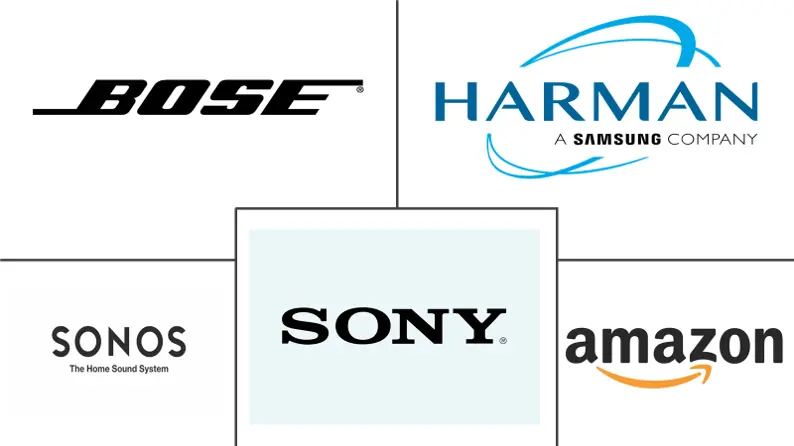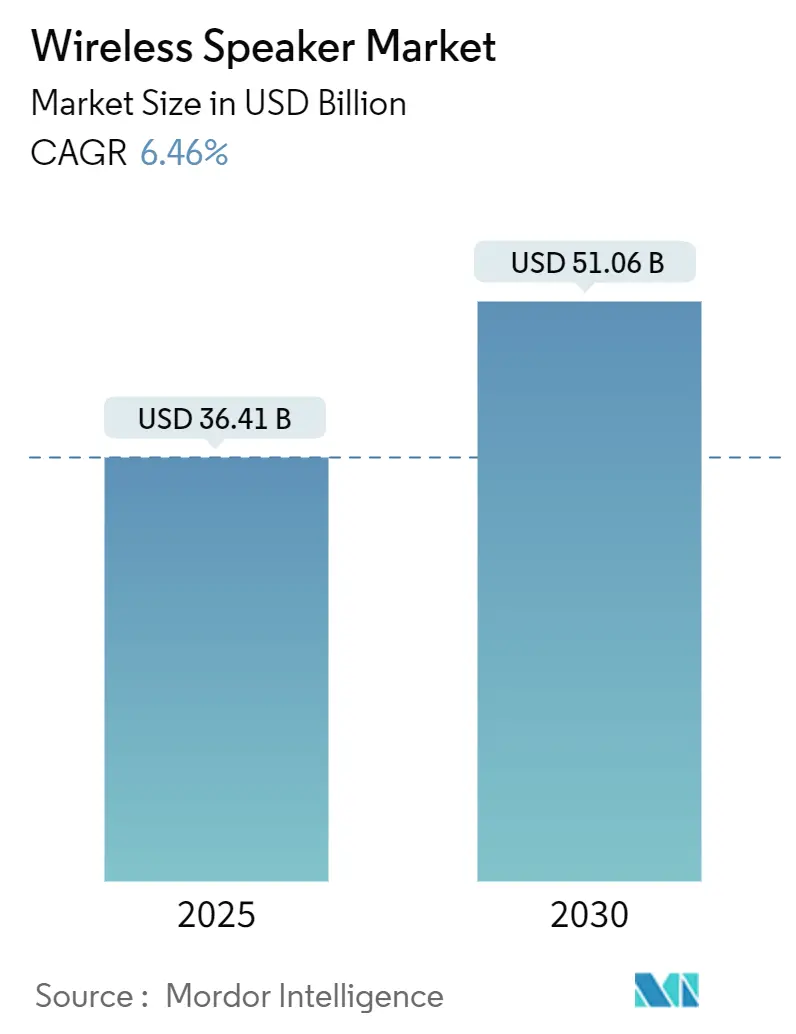
Wireless Speaker Market Analysis by Mordor Intelligence
The global wireless speaker market size is valued at USD 36.41 billion in 2025 and is forecast to reach USD 51.06 billion by 2030, advancing at a 6.96% CAGR. Escalating demand for always-connected audio, the spread of spatial-sound formats and tighter links between voice assistants and smart-home platforms continue to push volume as well as average selling prices. Asia-Pacific leads both size and growth thanks to smartphone ubiquity and competitive local brands, while North America sustains premium demand through content-centric ecosystems. Supply-chain visibility on Class-D amplifier ICs remains a differentiator, helping well-capitalised brands secure production slots. At the same time, automotive OEMs, enterprise hybrid-work tools and social-video-driven, ultra-portable devices create fresh use-case clusters that lift incremental revenue across the value chain. Competitive dynamics now revolve less around raw acoustic wattage and more around AI features, subscription hooks and cross-category integration.
Key Report Takeaways
- By connectivity type, Bluetooth commanded 52.1% wireless speaker market share in 2024, while smart speakers are forecast to expand at an 8.5% CAGR through 2030.
- By form factor, portable mini speakers accounted for 41.3% of the wireless speaker market size in 2024, whereas soundbars are projected to grow fastest at a 9.3% CAGR.
- By distribution channel, e-commerce captured 65.4% of the wireless speaker market size in 2024 and is advancing at a 7.4% CAGR to 2030.
- By end-user, residential use held 78.2% wireless speaker market share in 2024, while automotive OEM integration is rising at a 10.1% CAGR over the forecast period.
- By geography, Asia-Pacific led with 34.9% revenue share of the wireless speaker market in 2024 and is projected to expand at a 7.1% CAGR through 2030.
Global Wireless Speaker Market Trends and Insights
Drivers Impact Analysis
| Driver | (~) % Impact on CAGR Forecast | Geographic Relevance | Impact Timeline |
|---|---|---|---|
| Multi-room audio ecosystems adoption | +1.2% | North America & Western Europe | Medium term (2-4 years) |
| Voice-assistant integration in emerging Asia | +1.8% | China & India | Short term (≤ 2 years) |
| Dolby Atmos soundbar upgrades | +0.9% | Urban China & South Korea | Medium term (2-4 years) |
| Gen-Z short-video-led ultra-portable demand | +0.7% | Brazil & neighbouring markets | Short term (≤ 2 years) |
| Detachable speakers in premium EVs | +0.8% | Early adoption in North America & Europe | Long term (≥ 4 years) |
| Enterprise Bluetooth conference devices | +0.6% | Europe, spill-over to North America | Medium term (2-4 years) |
| Source: Mordor Intelligence | |||
Voice-assistant Integration Accelerating Smart-speaker Uptake in Emerging Asia
Smart-speaker adoption in China and India jumped when vendors embedded local-language, conversational AI and kept entry prices below USD 40. Amazon’s February 2025 launch of Alexa+, a generative-AI overlay that works on 600 million existing Echo devices, extended hardware life and introduced a USD 19.99 monthly revenue stream. Google’s pivot to Gemini AI for ambient computing signals a broader architectural shift toward cloud-native, multimodal voice experiences. Asian OEMs gain fast-follower advantage because they can license mature voice stacks instead of building proprietary solutions, cutting bill-of-material costs while raising perceived intelligence. Network effects from existing smart-home assets such as bulbs or cameras further lower adoption friction for first-time buyers.
Dolby Atmos Soundbar Upgrades Fueling ASP Growth in Urban China and South Korea
City-dwelling consumers in these markets are moving away from legacy 2.1-channel bars toward Dolby Atmos-enabled bundles that include wireless surrounds. MediaTek and Dolby unveiled FlexConnect in January 2025, allowing soundbars to auto-calibrate with any compatible speaker in the room, removing HDMI-cable constraints.[1]MediaTek Inc., “MediaTek and Dolby Atmos FlexConnect,” MediaTek, mediatek.com Sony’s BRAVIA Theatre line uses 360 Spatial Sound Mapping to simulate multi-speaker environments without ceiling drivers. Higher audio immersion supports USD 300-plus price points, lifting overall wireless speaker market average-selling-price even as unit volumes stay flat.
Automotive OEM Detachable-speaker Partnerships in Premium EVs
Electric-vehicle makers treat differentiated cabin sound as a selling point equal to range or acceleration. Cadillac’s OPTIQ and VISTIQ ship with 19- and 23-speaker Dolby Atmos packages able to detach for tail-gate scenarios, turning the vehicle into a mobile jukebox.[2]General Motors, “GM Brings Dolby Atmos with Amazon Music to Cadillac EV Lineup,” General Motors, news.gm.com McIntosh’s 19-speaker array in the Jeep Wagoneer S applies a similar strategy for lifestyle positioning. Meanwhile, HARMAN’s SeatSonic shifts loudspeakers into headrests, saving weight and energy while enabling driver-specific sound zones. These integrations open OEM revenue pools beyond traditional aftermarket upgrades and feed secondary demand for over-the-air EQ presets.
Hybrid Workspaces Driving Enterprise Bluetooth Conference Speakers in Europe
Return-to-office policies are fluid, so companies equip hot desks and huddle rooms with plug-and-play audio. The EPOS EXPAND 80 covers 16-person spaces through beamforming microphones and Teams certification.[3]EPOS, “EXPAND 80,” EPOS, eposaudio.com Jabra’s Speak 510 offers sub-USD 130 portability for remote staff, and beyerdynamic’s IP64-rated SPACE MAX provides 25-hour battery life for outdoor workshops. Enterprises prefer Bluetooth plus USB-C connectivity for frictionless switching between laptops and phones, underpinning double-digit shipment growth in Western Europe since 2024.
Restraints Impact Analysis
| Restraint | (~) % Impact on CAGR Forecast | Geographic Relevance | Impact Timeline |
|---|---|---|---|
| Bluetooth codec fragmentation | -0.40% | Japan & Germany | Medium term (2-4 years) |
| High import tariffs on finished devices | -0.60% | Brazil & India | Short term (≤ 2 years) |
| Privacy concerns around smart speakers | -0.50% | France & Canada | Long term (≥ 4 years) |
| Class-D amplifier IC shortages | -0.80% | Asian manufacturing hubs | Short term (≤ 2 years) |
| Source: Mordor Intelligence | |||
Smart-speaker Privacy Concerns Limiting Household Adoption in France and Canada
Supervisory authorities such as France’s CNIL remind users that voice data may feed undisclosed algorithm training, prompting stricter consent settings.[4]CNIL, “Assistants vocaux : les conseils,” CNIL, cnil.fr Surveys show over half of French and Canadian households fear unintentional eavesdropping despite appreciating convenience. Vendors respond with local-processing modes and physical mute toggles, yet scepticism slows replacement cycles and keeps the addressable base below neighbouring markets.
Class-D Amplifier IC Shortages Delaying Mid-tier ODM Production in Asia
Global chip turbulence pushed some audio-grade IC lead-times above 60 weeks in 2024, forcing contract manufacturers to redesign boards or accept lower margins. Texas Instruments introduced 1-inductor Class-D reference designs at CES 2025 to trim component counts. Brands with forward-buy agreements or multi-sourcing secure launch windows, while smaller ODMs risk missing peak holiday demand, tempering overall wireless speaker market expansion in the short term.
Segment Analysis
By Connectivity Type: Smart-speaker Growth Outpaces Bluetooth Leadership
Bluetooth held 52.1% of the wireless speaker market share in 2024, anchoring its dominance on ubiquity and pairing simplicity. Smart-speaker connectivity, helped by Wi-Fi dual-band chips and edge-AI advances, is forecast to rise at an 8.5% CAGR, gradually eating into basic Bluetooth volumes. The wireless speaker market size for cellular-enabled units remains low-single-digit, but satellite connectivity proofs-of-concept targeting RVs and maritime users hint at new price tiers. Emerging Bluetooth LE Audio with Auracast narrows latency, offering broadcast mode that can stream a concert feed to hundreds of personal speakers, reinforcing relevance for public venues. Legacy AirPlay-only devices continue to shrink as consumers request cross-platform support.
Wi-Fi-centric speakers outside the smart category sustain interest among audiophiles who prioritise lossless playback. Multi-room platforms now expose Matter-compatible schemas, easing interoperability pains. As chipset prices fall below USD 8, several tier-two Asian makers plan to upgrade entry-level models to Wi-Fi-plus-Bluetooth, balancing cost and ecosystem access.
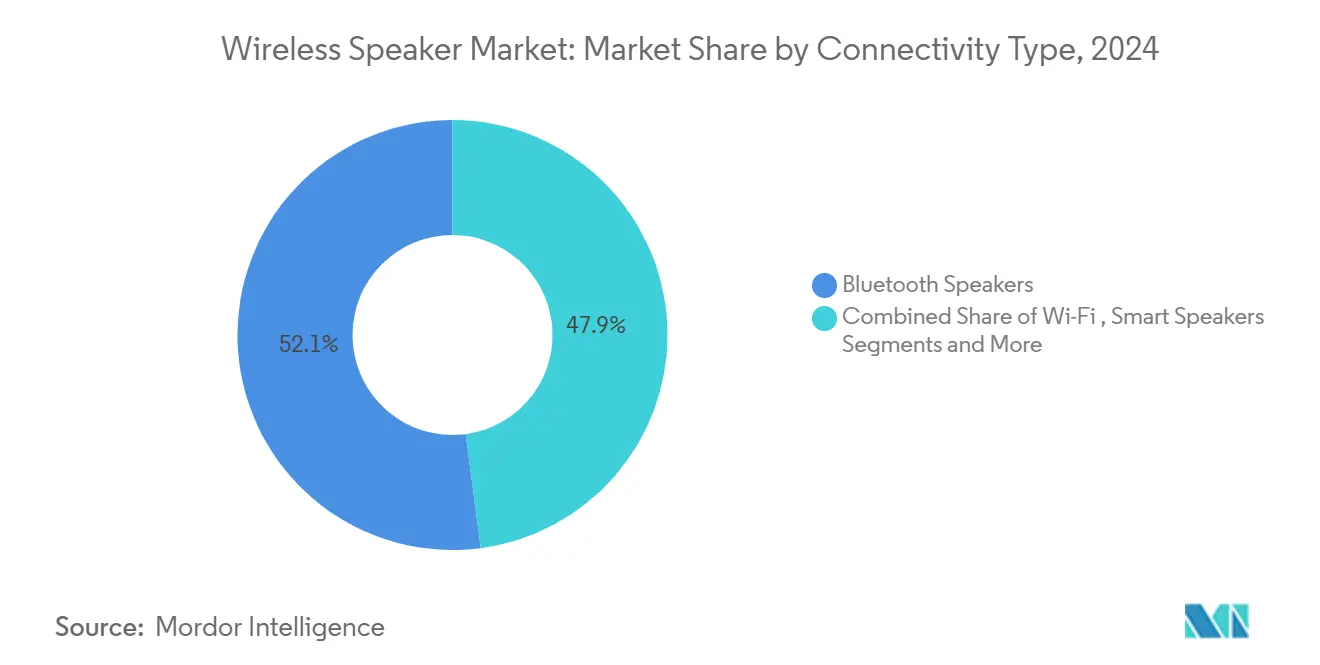
Note: Segment shares of all individual segments available upon report purchase
By Form Factor: Soundbars Capture Value While Minis Command Units
Portable minis contributed the largest shipment volume, translating into 41.3% of the wireless speaker market size in 2024. Nevertheless, soundbars delivered superior revenue growth, advancing at a 9.3% CAGR, because cinema-grade Atmos decoding lifts average prices. Party speakers add light shows and microphone inputs, tapping Gen-Z social-video behaviour. Rugged clip-on variants meet demand for biking and hiking audio, featuring IP67 ratings and 12-hour batteries. Floor-standing wireless towers occupy a high-margin niche serving living-room audiophiles unwilling to route speaker cables.
Smart-display speakers remain a hybrid segment merging voice, touch and video chat, finding adoption in kitchens for recipe walkthroughs or surveillance camera feeds. As mini-LED costs fall, manufacturers experiment with eight-inch panels on swivel mounts, preserving compact footprints.
By Distribution Channel: E-commerce Extends Its Lead
Online platforms represented 65.4% of the wireless speaker market size in 2024 and post the fastest 7.4% CAGR because comparison shopping and flash deals align with tech-savvy buyers. Brand-owned web-stores deepen margins by bundling extended warranties and music-service trials. Specialist audio retail still matters for USD 1,000-plus models where live demos influence perceptions of soundstage. Mass-merchandisers handle impulse purchases under USD 50, especially during holiday promotions.
Automotive dealerships increasingly bundle detachable cabin speakers, capturing yet another non-traditional channel. Commercial installers focus on hospitality and education, integrating ceiling speakers with BYOD wireless hubs to reduce wiring costs.
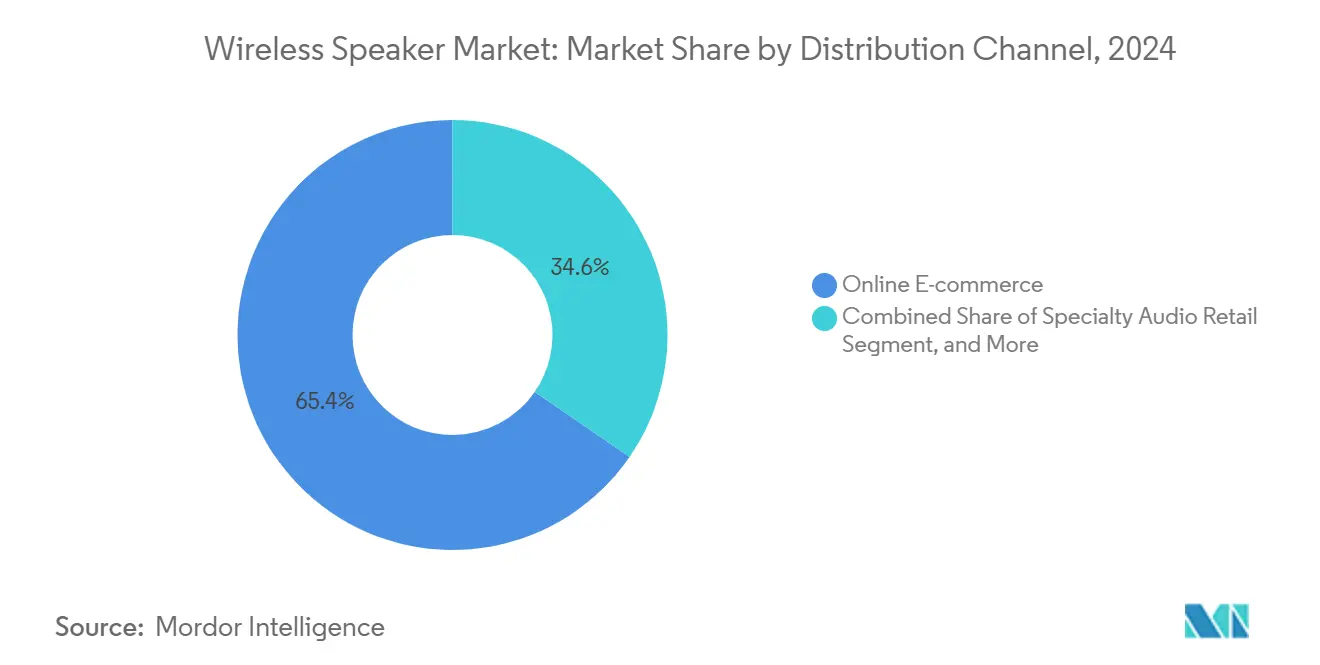
By End-User: Automotive OEM Uptick Amid Residential Dominance
Residential applications commanded 78.2% of the wireless speaker market size in 2024, confirming that multi-room audio and smart-home hubs remain core purchase drivers. Families increasingly position compact speakers in kitchens, bathrooms and outdoor spaces, turning voice control into a default household interface. Streaming-service bundles and seasonal discounting keep replacement cycles brisk as consumers upgrade to spatial-audio-ready models. Hotel chains and cafés add background-music speakers with Wi-Fi mesh support to elevate guest experience, though these commercial installs still trail the large residential base. Conference-room upgrades in hybrid workplaces contribute incremental demand, but enterprise volumes only nibble at overall wireless speaker market share when compared with home use [eposaudio.com].
Automotive OEM integration is the fastest mover, projected to expand at a 10.1% CAGR as electric-vehicle launches showcase detachable cabin speakers and Dolby Atmos arrays. Cadillac’s OPTIQ and VISTIQ EVs, for example, ship with 19- and 23-speaker packages that double as tail-gate sound systems, underscoring how premium audio now bolsters vehicle pricing power [news.gm.com]. Partnerships between audio specialists and carmakers also create recurring revenue via over-the-air EQ updates that refresh in-car sound without new hardware. Corporate fleets begin specifying portable conference speaker kits for mobile offices, further stretching the end-user mix. While residential units will keep leading absolute volumes, automotive deployments and niche professional uses together form the next growth leg for the wireless speaker market.
Geography Analysis
Asia-Pacific contributed 34.9% of 2024 revenue and is projected to rise at a 7.1% CAGR thanks to scale manufacturing, cost-competitive brands and rapid 5G handset take-up. China anchors volume, combining local AI platforms with sub-USD 25 entry devices. South Korea and Japan chase premium niches, though codec fragmentation postpones audiophile upgrades. India’s import-tariff hikes encourage domestic assembly, with several handset brands diversifying into speakers to capture accessory spend.
North America retains a sizeable premium segment, driven by subscription ecosystems linking smart speakers to home-security and media bundles. United States consumers show willingness to pay for AI enhancements such as Amazon Alexa+, whereas Canada’s adoption curve flattens because privacy concerns curb living-room placement. Mexico benefits from cross-border fulfilment centres that cut delivery times for mid-range products.
Europe remains a mixed picture. Western Europe outperforms on multi-room adoption, with Scandinavian markets favouring sustainable materials and repairability. France’s cautious stance on always-listening devices slows smart-speaker uptake, while Germany’s hi-fi enthusiasts wait for unified lossless Bluetooth before replacing wired rigs. Central and Eastern Europe expand entry-level Bluetooth sales via e-commerce, offsetting weaker retail networks.
South America sees brisk demand for ultra-portable speakers that double as content-creation props for short-video platforms. Brazil’s high duties push brands to move final assembly onshore or consider MicroSD-equipped models that sidestep streaming data costs. Chile and Colombia import mid-priced soundbars as fibre broadband coverage widens.
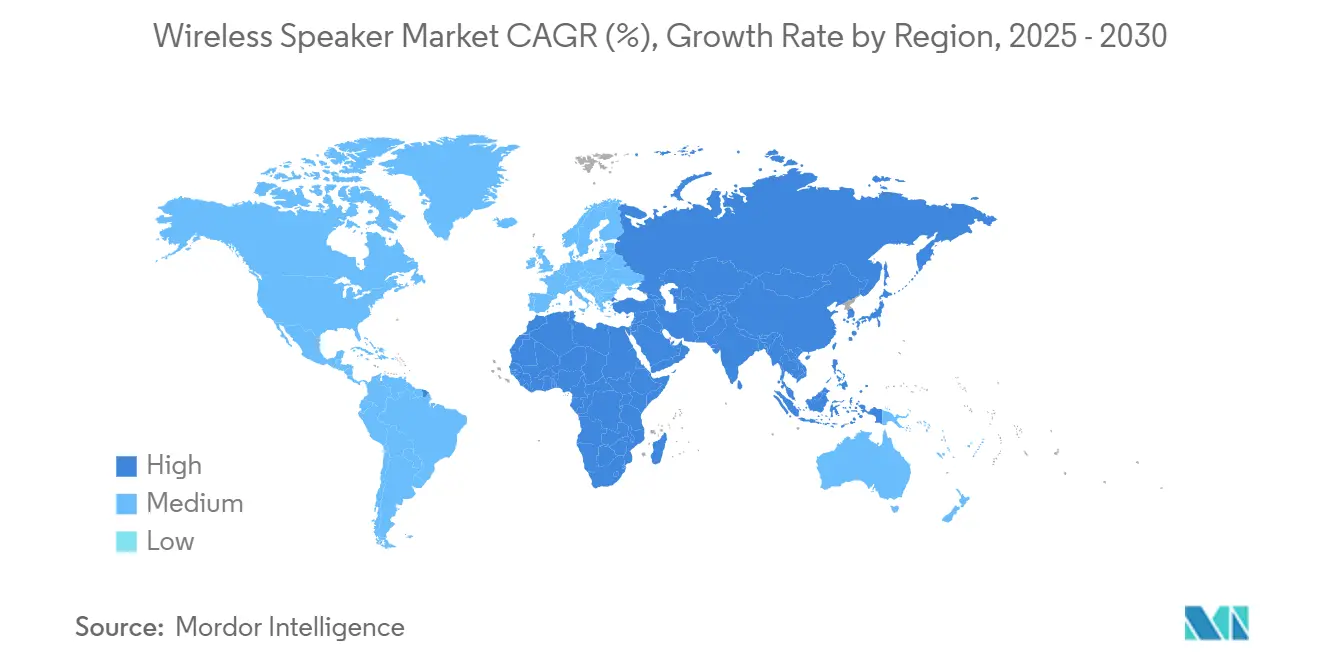
Competitive Landscape
Competition intensifies as platform owners leverage AI and subscription economics. Amazon, Google and Apple commanded roughly 45% of 2024 global shipments, bundling voice assistants and multi-room protocols to lock users in. Sonos, Bose and JBL defend share with acoustic engineering and brand equity, but face margin pressure as entry-level smart speakers close the perceived audio-quality gap. Samsung’s Harman subsidiary blends consumer, professional and automotive capabilities, fielding models that cross-sell to its TV and smartphone bases.
Emerging Chinese vendors such as Xiaomi and Anker grow rapidly on low-cost, feature-rich launches, often first to adopt new Bluetooth or battery chemistries. European specialists including Devialet position on design and patent-protected acoustic architecture, targeting luxury segments. Semiconductor shortages encourage vertical integration; Apple’s in-house silicon cuts reliance on merchant chips, while Sony and LG co-design Class-D stages with fab partners to secure allocations.
Strategic moves reveal two axes: ecosystem-centric expansion and niche-use-case specialisation. Amazon’s Alexa+ subscription illustrates the former, converting hardware users into recurring subscribers. At the other end, brands like EPOS capitalise on enterprise hybrid-work budgets by tailoring firmware for conferencing platforms. Automotive alliances, visible in GM-Dolby and Jeep-McIntosh tie-ups, signal a new battleground where cabin acoustics influence vehicle differentiation.
Wireless Speaker Industry Leaders
-
Bose Corporation
-
Samsung Electronics Co. Ltd. (Harman International Industries Inc.)
-
Sony Corporation
-
Amazon.com Inc
-
Sonos Inc.
- *Disclaimer: Major Players sorted in no particular order
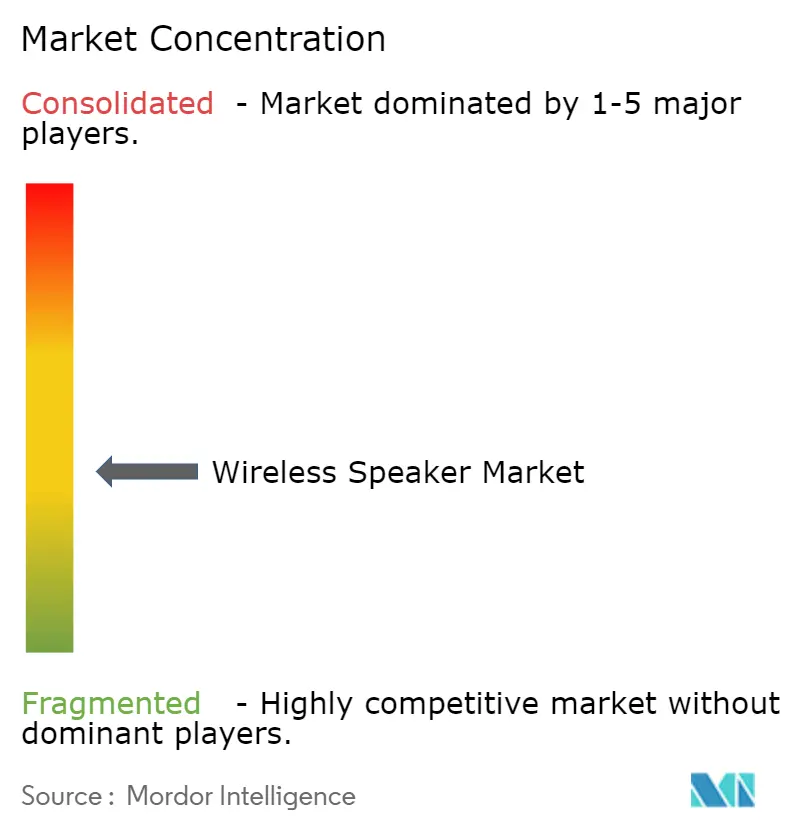
Recent Industry Developments
- March 2025: General Motors implemented Dolby Atmos with Amazon Music on Cadillac EVs, fitting 19- and 23-speaker arrays as standard.
- February 2025: Amazon introduced Alexa+, a generative-AI assistant compatible with 600 million Echo devices, priced at USD 19.99 monthly for non-Prime users.
- January 2025: LG unveiled its 2025 “xboom by will.i.am” lineup featuring signature sound profiles and onboard AI.
- January 2025: JBL rolled out the PartyBox 520, Encore 2 and Encore Essential 2 with AI Sound Boost and Bluetooth 5.4 LE Audio.
- January 2025: MediaTek and Dolby launched Atmos FlexConnect for cable-free soundbar pairing.
Global Wireless Speaker Market Report Scope
Wireless speakers are loudspeakers that acquire audio signals utilizing radio frequency waves rather than over audio cables. Wireless speakers are used to play music or other audio files through certain connectivity technologies. The studied market is segmented by different Connectivity Types such as Bluetooth, Wi-Fi (Incl. Combo Speakers and Excl Smart Speakers), and Smart Speakers among multiple geographies. The market sizes and forecasts are provided in terms of value (USD million) for all the above segments. The impact of COVID-19 on the market and impacted segments are also covered under the scope of the study. Further, the disruption of the factors affecting the market's expansion in the near future has been covered in the study regarding drivers and restraints.
| Bluetooth |
| Wi-Fi (incl. Combo, excl. Smart) |
| Smart Speakers |
| Cellular/LTE Speakers |
| Portable Mini/Pocket-Sized |
| Soundbars |
| Smart-Display Speakers |
| Floor-Standing/Tower |
| Clip-on/Sports and Outdoor |
| Online E-commerce |
| Specialty Audio Retail |
| Mass-Merchandisers/Hypermarkets |
| OEM-Fitted and Installer Networks |
| Resdential |
| Commercial |
| Hospitality Corporate/Enterprise |
| Automotive OEM |
| Others (Education, Public Venues) |
| North America | United States | |
| Canada | ||
| Mexico | ||
| Europe | Germany | |
| United Kingdom | ||
| France | ||
| Nordics | ||
| Rest of Europe | ||
| South America | Brazil | |
| Rest of South America | ||
| Asia-Pacific | China | |
| Japan | ||
| India | ||
| South-East Asia | ||
| Rest of Asia-Pacific | ||
| Middle East and Africa | Middle East | Gulf Cooperation Council Countries |
| Turkey | ||
| Rest of Middle East | ||
| Africa | South Africa | |
| Rest of Africa | ||
| By Connectivity Type | Bluetooth | ||
| Wi-Fi (incl. Combo, excl. Smart) | |||
| Smart Speakers | |||
| Cellular/LTE Speakers | |||
| By Form Factor | Portable Mini/Pocket-Sized | ||
| Soundbars | |||
| Smart-Display Speakers | |||
| Floor-Standing/Tower | |||
| Clip-on/Sports and Outdoor | |||
| By Distribution Channel | Online E-commerce | ||
| Specialty Audio Retail | |||
| Mass-Merchandisers/Hypermarkets | |||
| OEM-Fitted and Installer Networks | |||
| By End-User | Resdential | ||
| Commercial | |||
| Hospitality Corporate/Enterprise | |||
| Automotive OEM | |||
| Others (Education, Public Venues) | |||
| By Geography | North America | United States | |
| Canada | |||
| Mexico | |||
| Europe | Germany | ||
| United Kingdom | |||
| France | |||
| Nordics | |||
| Rest of Europe | |||
| South America | Brazil | ||
| Rest of South America | |||
| Asia-Pacific | China | ||
| Japan | |||
| India | |||
| South-East Asia | |||
| Rest of Asia-Pacific | |||
| Middle East and Africa | Middle East | Gulf Cooperation Council Countries | |
| Turkey | |||
| Rest of Middle East | |||
| Africa | South Africa | ||
| Rest of Africa | |||
Key Questions Answered in the Report
What is the current value of the wireless speaker market?
The wireless speaker market stood at USD 36.41 billion in 2025 and is on track to reach USD 51.06 billion by 2030.
Which region leads the wireless speaker market and why?
Asia-Pacific leads with a 34.9% revenue share due to high smartphone penetration, competitive local brands and large-scale manufacturing capacity.
How fast are smart-speaker connectivity segments growing?
Smart-speaker connectivity is projected to rise at an 8.5% CAGR between 2025 and 2030 as voice-AI capabilities improve and ecosystem integration deepens.
Which distribution channel is most important for wireless speakers?
E-commerce dominates with 65.4% of 2024 revenue and continues to grow fastest at a 7.4% CAGR, reflecting direct-to-consumer purchasing preferences.
Why are automotive OEMs important to the wireless speaker market?
Premium electric vehicles embed detachable, multi-speaker systems to differentiate cabin experiences, pushing the automotive segment to a 10.1% CAGR through 2030.
What are the major factors restraining wireless speaker adoption?
Key restraints include Bluetooth codec fragmentation in audiophile markets, privacy concerns in countries like France and Canada, and ongoing Class-D amplifier chip shortages.
Page last updated on:
